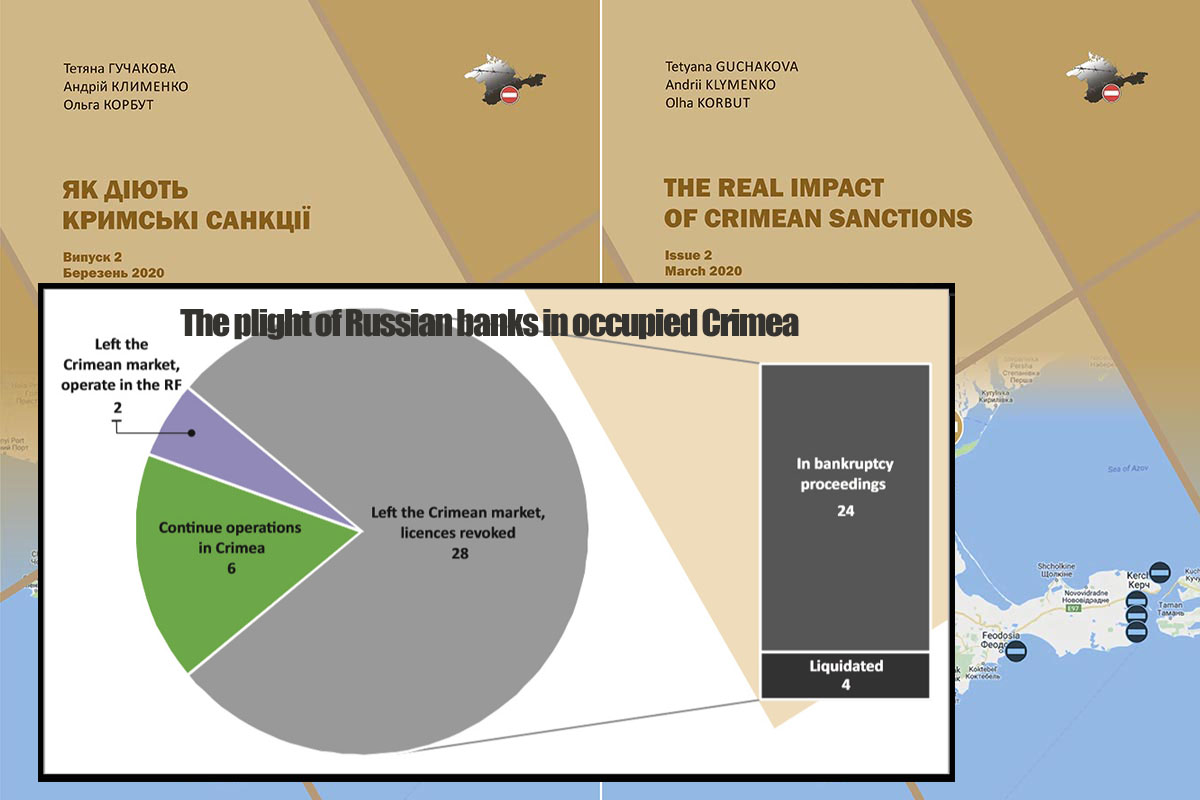The Real Impact of Crimean Sanctions (2). The Impact of Sanctions on the Crimean Banking
Andrii KLYMENKO, Tetyana GUCHAKOVA, Olha KORBUT
The Monitoring Group of the Black Sea Institute of Strategic Studies and BSNews
Translated from Ukrainian by HANNA KLYMENKO
The BlackSeaNews presents a series of publications on the real impact of Crimean sanctions on Russia's economy.
The contents include:
Crimea Occupation, Sanctions, and Blockade. The State of the Sanctions Regime as of 1 February 2020
The Impact of Sanctions on the Crimean Banking
The Impact of Sanctions on Maritime Connections with the Occupied Crimean Peninsula
Missed Deadlines for the Production of Karakurt Missile Corvettes at the Morye Shipyard in Feodosia
The Imposition of U.S. Sanctions against Russian Plants over the Production of Warships in Crimea
The Peculiarities of Economic Processes in Russia and Occupied Crimea under Sanctions
Russia's Investment in Fixed Capital in Occupied Crimea and Sevastopol. What Russian Investment Money is Spent on in Crimea and Sevastopol
The Heavily Subsidised Budget Model of Crimea and Sevastopol
The Updated "Crimean Sanctions Package"
The Policy of Non-recognition of the Attempt to Annex the Crimean Peninsula
The Cost of the Occupation to Russia and What Awaits Crimea and Sevastopol
The Impact of Sanctions on the Crimean Banking
Before the occupation, Crimea and the city of Sevastopol had an extensive network of branches of commercial banks.
The total of 67 banking institutions registered in mainland Ukraine had their branches on the peninsula — as well as 2 Crimean banks, The Black Sea Bank for Development and Reconstruction and Morskoy.
The occupying state planned to use Ukrainian financial institutions to mitigate its problems of the "transition period". However, none of the Ukrainian banks with branches in Crimea consented to continue working in the occupied territory under the Russian legislation, so the Russian banks tried to fill the void.
Over the period of occupation, at different times, 34 Russian banks started operations in Crimea. In addition, 2 local banks began operations under the RF jurisdiction, bringing the total to 36.
As of the beginning of 2020, 28 banks have had their licences revoked. Out of these, 4 banks have already been liquidated, 24 are currently in bankruptcy proceedings.
2 Russian banks that left Crimea after a brief attempt at work are still operating in the RF.
As of 1 January 2020, only 6 Russian banks have remained on the peninsula. All of them are now under international sanctions.
Due to sanctions, the large Russian banks that used to operate in Crimea before the occupation, namely Sberbank, Alfa-Bank and VTB have since stopped operations there and do not intend to resume them.
The situation has made a number of Western businessmen, who had initially visited Crimea in search of investment opportunities, later retreat taking a wait-and-see position. There is no question that it has happened mainly due to the sanctions, because of which European banks cannot work with the banks operating on the peninsula.
|
There are only 6 Russian banks still operating in Crimea compared with 36 ones in the first years of the occupation. All of them are now under sanctions. Banking sanctions make it impossible to invest in Crimea, even when it comes to private Russian investment, or use international payment systems and other financial services. |
to be continued...
* * *
The monitoring of violations of international sanctions against Russia and of the legal regime of the Crimean temporarily occupied territory, as well as the publication of this book, have been supported by the European Program of the International Renaissance Foundation. The views of the authors do not necessarily reflect the position of the International Renaissance Foundation.
More on the topic
- 01.07.2021 The Electronic Catalogue Research by Western Think Tanks on Crimea and the Situation in the Black Sea
- 22.01.2021 How the Sanctions Work. The Defense Industry of the Occupied Crimea
- 11.06.2020 The Maritime Expert Platform Association on Urgent Actions to De-Occupy Crimea and Counter the Occupation of the Sea of Azov and the Black Sea. Proposals
- 06.06.2020 The Real Impact of Crimean Sanctions (10-11). The Cost of the Occupation to Russia and What Awaits Crimea and Sevastopol
- 06.06.2020 The Real Impact of Crimean Sanctions (9). The Updated "Crimean Sanctions Package"
- 20.05.2020 The Real Impact of Crimean Sanctions (6-8). The Peculiarities of Economic Processes in Russia and Occupied Crimea under Sanctions
- 18.05.2020 The Real Impact of Crimean Sanctions (5): the Imposition of U.S. Sanctions against Russian Plants over the Production of Warships in Crimea
- 09.05.2020 The Real Impact of Crimean Sanctions (4). Missed Deadlines for the Production of Karakurt Missile Corvettes at the Morye Shipyard in Feodosia
- 07.05.2020 The Impact of Sanctions on Maritime Connections with the Occupied Crimean Peninsula (3)
- 04.05.2020 The Real Impact of Crimean Sanctions (1). The State of the Sanctions Regime as of 1 February 2020
- 03.03.2020 The policy of non-recognition of the attempt to annex the Crimean peninsula
- 13.02.2020 Russia's Economic War Against Ukraine in the Sea of Azov as of February 1, 2020. The Technology of Blocking the Mariupol and Berdiansk Ports



